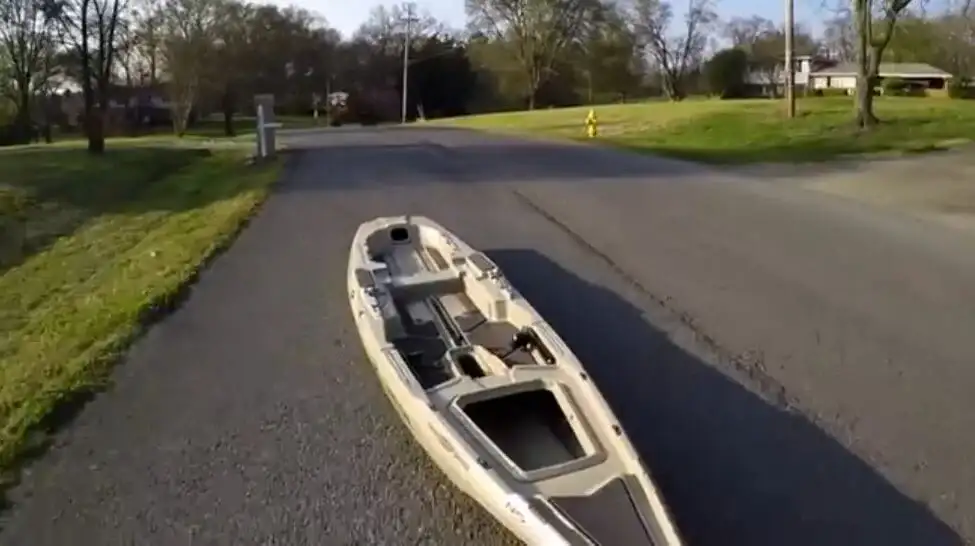Having a good competitive or leisure time kayaking requires strict safety measures.
This cuts across using of kayak flags, balancers and a lot more.
It also has a lot to do with how you take care of your kayak too.
This leads people to always ask can you drag a kayak?
You should avoid dragging your kayak at all cost to avoid the development of holes in your kayak. If the need to drag is high, it should be done occasionally and mostly on a soft surface.
A hole inside a kayak will destroy your safety in the water which is very dangerous.
This is because water will start entering the kayak through the hole.
As the water keeps accumulating in volume, the kayak eventually sinks.
So you should avoid dragging your kayak to avoid the emergence of openings in your kayak.
Why It Is Bad To Drag A Kayak
1) It Develops a Hole In a Kayak
A hole in a kayak is one of the things you should avoid at all cost.
Preventing this is totally dependent on how you take care of your kayak.
This covers situations when you are kayaking and when you are not kayaking too.
Dragging your kayak is one thing you should always try and avoid doing with your kayak.
This is because of the bad consequences that comes with it.
When you drag a kayak on a surface, a frictional force develops between the surface of the kayak and the surface you drag it on.
This causes the development of wear and tear depending on the roughness of the surface.
If the surface is really rough, the wear and tear will be high thereby leading to the development of a hole in the kayak.
So always try to avoid this to make sure that your kayak does not start developing holes.
2) It Causes a Kayak To Sink

One of the common things that will be noticed when a kayak is dragged is the development of holes in the kayak.
This is a very bad situation when you are kayaking on the water.
If there is a hole, water will start coming into the kayak gradually.
With continuous increase in the volume of water in the kayak, the kayak begins to sink gradually.
So always avoid situations that will lead to a hole in your kayak.
One of the chief culprit in this is when a kayak is dragged especially on a rough surface.
3) It Reduces The Lifespan Of a Kayak
When things are poorly maintained, they always face reduction in their lifespan.
This also applies to a kayak too.
when a kayak is poorly maintained, it develops cosmetic wear and tear.
This further leads to other critical damages that affects the lifespan of the kayak.
When this happens, it reduces the lifespan of the damaged kayak.
4) It Reduces The Safety And Reliability Of The Kayak
Nothing is as important as your safety when you kayak.
It does not just end in you wearing a life jacket.
It cuts across other areas too.
Such also includes the condition of the kayak that you make use of.
If the kayak is in a good condition, then it is reliable and safe to use.
But if the kayak has some flaws like serious cosmetic wear or has developed a hole, it becomes very unsafe to use.
This is because it is not reliable once it is put on water.
To avoid risking your life, avoid kayaks with serious cosmetic wear or holes.
How To Avoid Dragging Your Kayak
Most of the times we face situations that warrants us to drag our kayak even though we would not want to on a normal day.
This is why you should be very proactive on things to carry along before leaving your house to kayak.
This will help you reduce the possibility of dragging your kayak.
Some of these include;
1) Deflate Your Inflatable Kayak When You Finish Kayaking
When you are out of the water, make sure that you deflate your inflatable kayak.
This will reduce the chances of you trying to drag your kayak.
After you have finished deflating your kayak, make sure that you bag it well in its appropriate kayak bag.
2) Always Go With Your Kayak Pump
One of the things that leads to the drag of a kayak is when you do not have a kayak pump.
When you do not have a pump to inflate your kayak, you will always want to keep your kayak inflated all the time.
When this occurs, moving your kayak will always be associated with a drag at some point.
So always make sure you go with a kayak pump if you are making use of an inflatable kayak.
This will give you the liberty to deflate and inflate your kayak anytime the need arises.
3) Use a Kayak Trolley
For those that have a plastic kayak, it is important to have a kayak trolley too.
This will help you move your kayak in a very safe manner without damaging it from dragging.
Also it will help you transport your kayak without disobeying highway rules and regulations.
Such comes when you tie a large kayak to your car.
This can lead to an accident on the road if something goes wrong.
But with the use of a kayak trolley, you can easily move your kayak anywhere safely.
This will eliminate the need for you to drag your kayak especially on a hard surface.
4) Always Carry a Kayak Bag For Inflatable Kayak
Carrying a kayak bag is very important.
This is very crucial if you are using an inflatable kayak.
This will come as a boost to the safety of your kayak.
It will help you move your kayak easily after deflating it.
This will also eliminate situations of dragging your kayak.
How To Drag A Kayak Safely
1) Do Not Drag Inflatable Kayaks On Grasses With Thorns
One of the ways of protecting an inflated object is to keep it away from sharp objects.
This applies to an inflatable kayak too.
When a kayak is inflated, it is very prone to damage with it contacts a sharp object.
Such could be a grass with thorn when you drag a kayak.
So always avoid the dragging of a kayak on a thorny grass.
2) Avoid Dragging a Plastic Kayak On a Rough Surface

Always make sure that you avoid situations that lead you to pull your kayak on a rough surface.
This will further increase the lifespan of the kayak.
Also, holes will not develop in the kayak when they are not moved on a hard or rough surface.
This helps in also increasing the safety and reliability of the kayak also.
3) Drag a Plastic Kayak On Sand Or Grass

If you want to drag a plastic kayak, let it be on a soft surface.
This could be a sand surface or a grass surface.
This will reduce the level of wear and tear that the kayak will receive thereby increasing its safety.
4) Attach a Stud When You Drag Plastic Kayak On Hard Surface
In case you want to drag on a hard or rough surface, make sure that the safety of the kayak is a top priority.
One way of ensuring this is by using a stud at the base of the kayak that will have contact with the hard surface.
With this, you protect the kayak from wear and tear.
If the surface is too rough, the damage will only come to the stud used at the base of the kayak instead of the kayak.
This will further enhance the safety of the kayak.
Is It Ok To Drag A Kayak

Dragging a kayak depends on the type of kayak that you want to drag.
Also, it depends on the surface that the kayak will be dragged on.
For a plastic kayak, you can drag it on a soft surface like sand or grass.
This will not render much cosmetic damage or puncture a hole in the kayak from dragging.
But if the surface is a hard and rough one like a concrete or asphalt surface, then you should avoid dragging it at all cost.
This is because the friction between the kayak and the rough surface will be very high.
This will lead to a fast destruction of the kayak surface and further development of holes.
If the kayak is an inflatable kayak, it is more prone to damage from dragging.
But it can be dragged on a soft surface like sand or grass sparingly.
But always avoid dragging kayaks on hard surfaces.
Can You Drag An Inflatable Kayak
Yes you can drag an inflatable kayak.
But when doing this, you must pay attention to the safety of the kayak.
This entails that you drag it on a surface that will not cause damage to the kayak.
With this, you should drag it on a soft surface.
This may be on a sand or on a grass surface.
But do not drag it on a hard surface like a concrete surface as this will quickly wear off the surface of the inflatable kayak.
Can You Drag A Plastic Kayak

Yes you can drag a plastic kayak on a surface.
Dragging a kayak that is made of plastic is more resistant to damage when compared to dragging an inflatable kayak.
You can drag it on a soft surface like sand or grass.
Always avoid extensive drag time when you drag on a hard surface like concrete.
The longer the drag time on the hard surface, the higher the friction developed.
This further leads to the wearing off of the surface of the kayak.
When this occurs, it is very dangerous to use such a kayak on the water.
With a hole developed from the strenuous dragging, water will enter the kayak thereby leading to sinking.
So always try to avoid dragging a kayak at all cost to preserve its lifespan.
Conclusion
Can you drag a kayak should not be a scary question to you anymore now that you have learnt how best it can be done safely.
But at all cost, always try to avoid it when you can.
This will help in prolonging the lifespan of your kayak and your safety when you kayak.
Further Reading
How To Keep Kayak From Sinking
Is An Inflatable Kayak Safe In The Ocean
